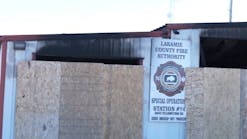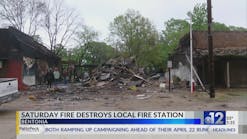Arsonists Targeting Blighted Neighborhoods in Flint, MI
By Ron Fonger
Source mlive.com (TNS)
FLINT, MI – When the house next door burned for the fourth time in October, Julie Mcmann started having a recurring dream.
Nothing remained of the home on Kentucky Avenue except the chimney and a deep hole filled with charred wood and burned bricks. It stayed that way through the winter and spring before the foundation was fenced off with plastic mesh.
“It was really scary during the winter because, you know, it’s slippery and I kept having nightmares of falling in that hole,” said Mcmann, 59. “I complained and complained about that house because we had people going in there, taking drugs, taking tricks ... I kept telling (the Genesee County Land Bank) to please come board it up, and I couldn’t get them to.”
Mcmann is one of 80,000 residents who have stuck it out in Flint, a city with housing and infrastructure built for 200,000. As jobs disappeared and people moved on, the growing number of vacant, tax-foreclosed homes, empty schools and abandoned businesses became and remain fuel for the arsonist’s torch.
A recent MLive-The Flint Journal investigation shows arsons were up 41 percent in 2023 compared to 2022 and are on a pace to eclipse that in 2024, up 25% compared to the same period last year. The investigation also shows that hundreds of other structure fires during the last two years have been classified as suspicious, meaning they also may have been intentionally set.
City leaders say there are a multitude of reasons why Flint’s chronic arson problem hasn’t abated over the decades. Squatters, thrill-seekers, jilted tenants and the mentally ill are routinely blamed for fires that are most often classified as suspicious. Officials believe some of the culprits are also law-abiding neighbors fed up with abandoned homes on their streets.
“The uptick in these arsons could be a level of frustration in the community because you have a lot of dilapidation and blight in areas that (are) not coming down fast enough for the residents,” said Flint Mayor Sheldon Neeley.
The pinpoints on this map represent fires classified as suspicious or intentional according to Flint Fire Department reports
THE FIRES
Flint has a long history with arson and suspicious fires that coincided with the economic decline and abandonment in the 1970s, ‘80s and ‘90s.
In 2012, the city had the highest per-capita arson rate nationwide among cities with populations of at least 100,000 with 353 intentional fires.
Then things slowly started to get better. The numbers dropped.
Until now.
Last year, Flint’s internal tracking attributed 82 fires to arson, the most in at least the last five years. It amounted to a 41 percent increase compared to 2022.
MLive-The Flint Journal spent months reviewing hundreds of individual fire scene reports from the past two years, interviewing city officials to determine how and why arsonists continue to torch the city and talking to dozens of people who still live in the most fire-prone areas.
The investigation revealed that part of the issue may be with the statistics.
FBI statistics show arsons have declined sharply in the past decade, but police said those numbers are misleading.
Detective Sgt. Tyrone Booth said Flint’s system for reporting arsons changed while the city was run by state-appointed emergency managers and some cases didn’t migrate into state and federal databases.
MLive’s review of fire reports from 2022 and 2023, requested through the Freedom of Information Act, included all reports of structure fires classified by firefighters as suspicious or intentional.
The review showed there were 325 such fires in those two years. Flint’s internal reporting shows the city classified 135 of those fires as arsons.
Even as the fires rage – and are lodged in the record books as suspicious or intentional – only a handful result in prosecutions.
Genesee County Prosecutor David Leyton said just five arson cases originating in Flint were active in Genesee district and circuit courts in early May.
The fires burned in most every area of Flint but have been most concentrated on the city’s east side. Arlington Avenue and Court Street both had six such fires from 2022 to 2023.
In one pocket of the city — from I-475 on the east, North Dort Highway on the west, Whaley Park on the north and Longway Boulevard on the south — there have been six dozen such fires during the two-year span, including four structures that burned multiple times.
There were three fires on Kentucky Avenue during that period, including a May 2022 blaze at a county Land Bank-owned home that had been previously burned.
Five months prior, a 59-year-old man died after he attempted to save a dog trapped inside a burning garage down the street from Mcmann.
“I’ve seen a lot living here,” she said. “When I first moved in, it was beautiful, so beautiful. Many people owned their own property. They took care of it and as people moved or passed away, we got renters and people stopped caring.”
MISSOURI STREET
The impact of arson smolders in the neighborhoods.
On Missouri Street, Duane Hanson has lived in his yellow, single-story home for more than 50 years.
He moved to Flint from North Dakota, lured with thousands of others by good-paying auto industry jobs.
“My kids, my grandkids went there,” he said of Washington Elementary School, which was demolished late last year after it was closed by the Flint Community Schools.
Before demolition, Flint firefighters responded to eight fires at the building since 2017, including a 2021 fire that left much of the structure reduced to rubble.
Flint’s abandoned schools have increasingly become arson targets. A review of city records by MLive shows that Flint firefighters have responded to more than 70 fires at deserted schools since 2017.
Neighbors lived around the massive nuisance of Washington for years before the demolition finally occurred.
“You get tired of looking at the damn things,” Hanson said of many of the houses that have burned and that taken years to clear. “We got so damn many.”
THE FUEL
Flint’s arson problem begins with its blight problem. And the blight problem starts with economic decline and population loss. In the 2020 census, Flint’s population dropped below 100,000 for the first time since 1930.
According to a 2022 report of the Land Bank, roughly one in four homes – more than 8,400 — in the city are vacant, blighted or both, making them prime potential burn candidates.
Past demolitions of abandoned or burned structures have left more than 16,000 vacant lots.
There are 37,152 structures remaining on 54,986 parcels in the city, according to the Flint Property Portal. The Land Bank owns 12,895 of those, including 3,194 structures in poor or substandard condition.
The agency doesn’t have funding to demolish everything in its inventory, all of which comes through tax foreclosures, and is the single biggest victim of arson in Flint.
Christina Kelly, director of planning and neighborhood revitalization for the Land Bank, said 730 of the 850 structures recorded as standing and previously burned in the Property Portal are Land Bank-owned.
But Kelly said there are likely many more burned structures that haven’t been tracked or recorded because there hasn’t been a recent citywide housing condition inventory.
Michael Freeman, executive director of the Land Bank, said some of the houses lost to fire have been candidates for rehabilitation before they were burned.
“We’ve had properties that we have considered redeemable or that they could be renovated through one of our sales programs and then someone gets in and burns it down,” Freeman said. “We show up for real estate pictures and there’s nothing here. There’s just a slab or a foundation.”
WEST JAMIESON STREET
On West Jamieson Street, where firefighters reported five suspicious or intentional fires since 2022, Lillian Blacknall said the blazes have changed everything in the city she grew up in.
“It’s quiet now. I don’t have no neighbors. A lot of them moved. A couple of them died,” the 74-year-old grandmother said.
When properties are left vacant, the question becomes when – not if – they will burn.
From her front porch, Blacknall can see where multiple fires burned — a nightclub that was just down the block on North Saginaw Street, a church less than a block from her home, and two houses next door, one of which was set on fire twice in three days last July, according to Flint fire reports.
“I hope it don’t come further down the street,” she said. “When I first moved over here, these were good neighbors. Now when I go to bed, it’s hard to sleep.”
THE LEADERS
Much of the east side is represented by 4th Ward Councilwoman Judy Priestley, who calls arson a plague on the city.
Beyond the danger of fires spreading to occupied buildings, burned-out structures are lasting eyesores. But there’s a long waiting list for demolitions, she said.
Standing in one of the east side neighborhoods in April, Priestley could see four scorched homes that scar the landscape. She believes targeted investigations and arrests are needed because fire-setters “feel like there’s nothing they can do to them.”
“Let’s get some of these people who are burning our city put away,” Priestley said during a City Council meeting on May 28.
Less than a month later, Councilwoman Tonya Burns told Fire Chief Theron Wiggins that residents can’t help but notice the increasing number of suspicious fires.
“You have an arsonist – one, two or three of them – and they’re running around with gasoline and matches it seems like,” Burns said. “I know you’re chasing fires. They light Stewart School or one of the public schools on fire every few days.”
Wiggins said he’s initiated changes designed to make arson investigations more effective and streamlined but said there’s no reason to investigate every fire as a crime, tying up firefighters, police and prosecutors on cases that have proven difficult to prove.
Despite last year’s spike in intentionally set fires, Wiggins said there are far fewer arsons here than there were when he served his first stint as chief under former Mayor Woodrow Stanley. A former arson investigator, Wiggins was first appointed fire chief in 1996 after 22 years with the department.
Wiggins said he’s not pushing to record higher arson numbers when many fires set by squatters or mentally ill people don’t meet the criteria for criminal prosecutions.
Flint Fire Department reports show dozens of suspicious and intentional fires have been attributed to people who suffer from mental health issues, cases that don’t lead to easy convictions.
“I cannot deem every fire that we go to as an arson fire,” he said. If he did, “these guys (investigators and prosecutors) would never have a break.”
INDIANA AVENUE
Troy Ance, 59, has lived on Indiana Avenue just a few years, but has already seen fires up, down and around where the former Angelo’s Coney Island office burned on Franklin Avenue, near Davison Road, last July.
Born in the Traverse City area where “you don’t see this stuff,” he moved to the east side after his wife secured a job here.
“Where else are you going to get a house for $3,000?” he asked.
But the low price reflects his surroundings.
Ance said homes targeted by arsonists are also targeted by scrappers.
Because police are slow to respond to complaints about scrapping, he said, neighbors don’t know if trespassers are people just trying to make a buck or would-be arsonists.
“Hundreds of people scrap in Flint,” he said. “People scrap to get their drugs.”
When he helped put out one vacant house fire, Ance found the accelerant, a tar-like substance, stuck to soles of his shoes after he tried to stomp out the flames.
“They’ve taken out a lot of houses around here ...,” he said. “Ninety-nine percent of them are intentional.”
THE SOLUTIONS
Youngstown, Ohio, has blazed a different path in the past couple decades.
Both Youngstown and Flint lost tens of thousands of residents since their heydays. Those people left behind thousands of empty houses and commercial buildings. As recently as 2015, Youngstown had 182 reported arsons, among the highest rates in the nation.
In 2022, it had just 15.
Local leaders attribute the drop to the city’s success in tearing down or renovating its vacant houses.
Youngstown focused revitalization efforts in neighborhoods that still have hope, bringing down the number of abandoned structures and therefore arson numbers, according to Youngstown officials MLive spoke with.
Back in Flint, there are a few changes in the works that could help, including a massive demolition initiative led by the Land Bank and funded with more than $50 million in federal stimulus and other funds.
The program aims to tear down 1,900 more structures in the Flint area.
Wiggins said another city initiative that involves a change in process could also help. Police currently handle arson investigations but a fire prevention officer from the fire department is in training to take over that job, making him “totally equipped to do it all,” much like Wiggins said he once was.
The department is also pursuing funding to purchase an accelerant-sniffing dog, a tool once used to make arson cases stick in court. The loss of the dog wasn’t the only hit the fire department took after Flint lost a $7.9-million federal grant that in 2014 paid the salaries of 39 firefighters.
But it all starts with blight, according to officials, and if the city can’t bring down the vacant homes, people in the neighborhoods will find their own solutions.
“Arson, in some cases, is people … trying to take the problem into their own hands to deal with it,” said Kelly. “Unfortunately, it’s not productive. It’s destructive and it’s not safe. It’s not a good strategy.”
©2024 Advance Local Media LLC. Visit mlive.com. Distributed by Tribune Content Agency, LLC.






